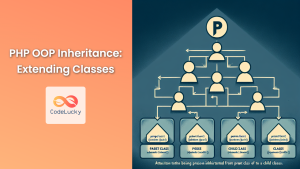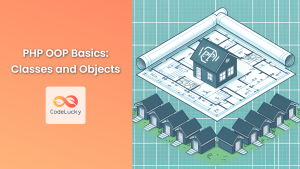In the world of Object-Oriented Programming (OOP) in PHP, static methods and properties are powerful tools that allow you to create class-level members. These members belong to the class itself rather than to any specific instance of the class. Today, we'll dive deep into the concept of static methods and properties, exploring their uses, benefits, and potential pitfalls.
Understanding Static Members
Static members in PHP OOP are declared using the static keyword. They can be accessed without creating an instance of the class, making them useful for utility functions and shared data across all instances of a class.
Let's start with a simple example to illustrate the concept:
class MathUtility {
public static $pi = 3.14159;
public static function square($number) {
return $number * $number;
}
}
// Accessing static property
echo MathUtility::$pi; // Output: 3.14159
// Calling static method
echo MathUtility::square(5); // Output: 25
In this example, $pi is a static property, and square() is a static method. Notice how we can access them using the class name followed by the scope resolution operator (::), without creating an instance of the MathUtility class.
When to Use Static Members
Static members are particularly useful in several scenarios:
- 🧰 Utility Functions: When you have functions that don't require object state.
- 🌐 Global State: For maintaining data that should be shared across all instances of a class.
- 🏭 Factory Methods: To create and return instances of a class.
- 🔢 Constants: Although PHP has a separate
constkeyword, static properties can be used for mutable class-level constants.
Let's explore each of these use cases with practical examples.
Utility Functions
Imagine we're building a text processing application. We can create a TextUtility class with static methods for common operations:
class TextUtility {
public static function reverseString($string) {
return strrev($string);
}
public static function countWords($string) {
return str_word_count($string);
}
}
$text = "Hello, World!";
echo TextUtility::reverseString($text); // Output: !dlroW ,olleH
echo TextUtility::countWords($text); // Output: 2
These utility functions don't need any object-specific data, so they're perfect candidates for static methods.
Global State
Static properties can be used to maintain state across all instances of a class. Let's create a User class that keeps track of the total number of users:
class User {
private $name;
private static $userCount = 0;
public function __construct($name) {
$this->name = $name;
self::$userCount++;
}
public static function getUserCount() {
return self::$userCount;
}
}
$user1 = new User("Alice");
$user2 = new User("Bob");
$user3 = new User("Charlie");
echo User::getUserCount(); // Output: 3
Here, $userCount is a static property that keeps track of how many User objects have been created. The getUserCount() static method allows us to retrieve this value without creating a User instance.
Factory Methods
Static methods are often used as factory methods to create instances of a class. This pattern is particularly useful when object creation is complex or when you want to return different subclasses based on certain conditions.
Let's create a ShapeFactory class:
abstract class Shape {
abstract public function getArea();
}
class Circle extends Shape {
private $radius;
public function __construct($radius) {
$this->radius = $radius;
}
public function getArea() {
return pi() * $this->radius * $this->radius;
}
}
class Rectangle extends Shape {
private $width;
private $height;
public function __construct($width, $height) {
$this->width = $width;
$this->height = $height;
}
public function getArea() {
return $this->width * $this->height;
}
}
class ShapeFactory {
public static function createShape($type, $dimensions) {
switch ($type) {
case 'circle':
return new Circle($dimensions[0]);
case 'rectangle':
return new Rectangle($dimensions[0], $dimensions[1]);
default:
throw new Exception("Unknown shape type");
}
}
}
$circle = ShapeFactory::createShape('circle', [5]);
echo $circle->getArea(); // Output: 78.539816339745
$rectangle = ShapeFactory::createShape('rectangle', [4, 5]);
echo $rectangle->getArea(); // Output: 20
In this example, ShapeFactory::createShape() is a static factory method that creates and returns different Shape objects based on the input parameters.
Constants
While PHP has a const keyword for defining true constants, static properties can be used for mutable class-level constants. This can be useful when you need to change the value at runtime:
class Configuration {
public static $debugMode = false;
public static $maxConnections = 100;
public static function enableDebugMode() {
self::$debugMode = true;
}
public static function setMaxConnections($count) {
self::$maxConnections = $count;
}
}
echo Configuration::$debugMode; // Output: false
Configuration::enableDebugMode();
echo Configuration::$debugMode; // Output: true
echo Configuration::$maxConnections; // Output: 100
Configuration::setMaxConnections(200);
echo Configuration::$maxConnections; // Output: 200
In this example, $debugMode and $maxConnections are static properties that act as mutable constants. They can be changed at runtime using static methods.
The static Keyword in Method Calls
When referring to static properties or methods within a class, you can use the self keyword or the class name. However, when dealing with inheritance, the static keyword becomes useful. It allows for late static binding, which means the reference will be resolved at runtime based on the class that's actually being called.
Let's see an example:
class Animal {
protected static $sound = "...";
public static function makeSound() {
echo static::$sound;
}
}
class Dog extends Animal {
protected static $sound = "Woof!";
}
class Cat extends Animal {
protected static $sound = "Meow!";
}
Animal::makeSound(); // Output: ...
Dog::makeSound(); // Output: Woof!
Cat::makeSound(); // Output: Meow!
In this example, if we had used self::$sound instead of static::$sound in the makeSound() method, all calls would have output "…" regardless of the actual class being used.
Potential Pitfalls of Static Members
While static members are powerful, they come with some potential drawbacks:
- 🔒 Global State: Static properties essentially create global state, which can make code harder to reason about and test.
- 🧪 Testing Difficulties: Static methods can be harder to mock in unit tests.
- 🔗 Tight Coupling: Overuse of static members can lead to tight coupling between classes.
- 🏃♂️ Performance: In some cases, static properties might not be as performant as object properties.
To mitigate these issues, use static members judiciously and consider alternatives like dependency injection when appropriate.
Best Practices for Using Static Members
To make the most of static members while avoiding potential pitfalls, consider these best practices:
- 📏 Use static methods for operations that don't require object state.
- 🧠 Prefer dependency injection over static methods for better testability.
- 🔍 Use static properties sparingly, mainly for truly class-level data.
- 📚 Document your static members clearly, especially if they maintain state.
- 🔄 Consider using the Singleton pattern instead of static members for complex shared state.
Conclusion
Static methods and properties in PHP OOP provide a powerful way to create class-level members. They're excellent for utility functions, factory methods, and maintaining shared state across instances. However, they should be used judiciously to avoid the pitfalls of global state and tight coupling.
By understanding when and how to use static members effectively, you can write cleaner, more efficient PHP code. Remember to always consider the trade-offs and choose the approach that best fits your specific use case.
Now that you're equipped with this knowledge, go forth and leverage the power of static members in your PHP projects! Happy coding! 🚀👨💻👩💻



















